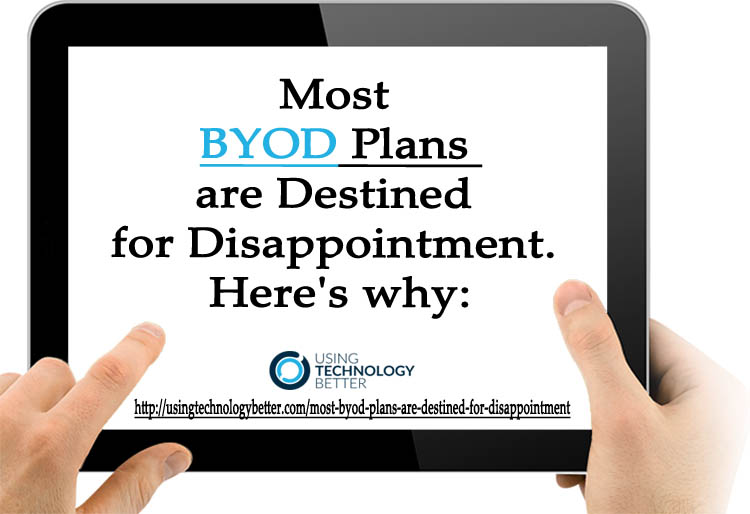One of my frustrations this year has been how most schools I’ve worked with have had a bring-your-own-device (BYOD) plan that left them disappointed and confused.
It’s not that they didn’t try. The problem hasn’t been with their vision or their commitment to change. They have done their research, been to conferences and undergone training. Yet they haven’t achieved the result they want.
Here are the reasons why most BYOD plans are destined for disappointment.
1) Too often, schools want to start with the discussion about which device is the best.
If your goal is to put the best educational technology in the hands of your students, you have the wrong goal. Using the best technology shouldn’t be the goal.
Yeah, I know that the goal is to improve student outcomes. But if this were the case, why do we ask what technology is the best instead of how we can improve student outcomes?
A one-to-one program won’t solve your problems. It can exacerbate them! If you don’t have a clear vision for how technology will improve teaching and learning within your school’s context, you’re wasting your time.
When you start the discussion, quite often, the device you prefer dictates the vision, the infrastructure, the training for the staff and, ultimately, the pedagogy.
So just for a minute, forget technology exists and answer the question, how do we want our students to learn? When you can answer in crystal-clear detail, you’re ready to formulate your strategy.
As you progress, change your strategy to address the issues that arise. But as you do, continue forming your vision and the culture that will ensure your success.
2) You don’t really have a perspective secure enough to avoid pitfalls.
While formulating their BYOD plan in the vacuum of accurate information, schools tend to do so under the proverbial microscope. By this I mean they lack the necessary breadth of experience and perspective that enables them to learn principles from a range of learning contexts. Principles are transferrable, programs aren’t.
Too often the problem is a case of the blind leading the blind.
Most BYOD plans were drawn up in response to another school’s model. The problem with following models developed by others is, it’s THEIR model.
I’m yet to attend a conference where a presenter stood up and outlined in detail his school’s struggles, failures and disappointments.
But the reality is: Every effective BYOD plan has addressed specific issues within a school.
But if you’d copy another school’s plan, your plan will never be as effective because your situation is unique.
To ensure your BYOD plan is effective, you need to rise above the details, get a clear view and then navigate your path to your goal.
What is the best way?
We have developed a Digital Leadership for Learning Program that aims to help you gain a clear perspective of how to achieve your goal, as well as provide to you the tools necessary to formulate your very own BYOD plan that works.
We will fast track you through the fundamental principles needed to formulate your plan that are specific to you and your unique learning context, as well as provide to you ongoing support and coaching to see you meet if not exceed your goals.
Our program was launched at the beginning of 2015 in Australia and New Zealand. Plans are in place to accommodate other countries if there is demand.
Our program is the same for all counties, but the face-to-face sessions conducted at each location is unique.
Contact us to learn more.











